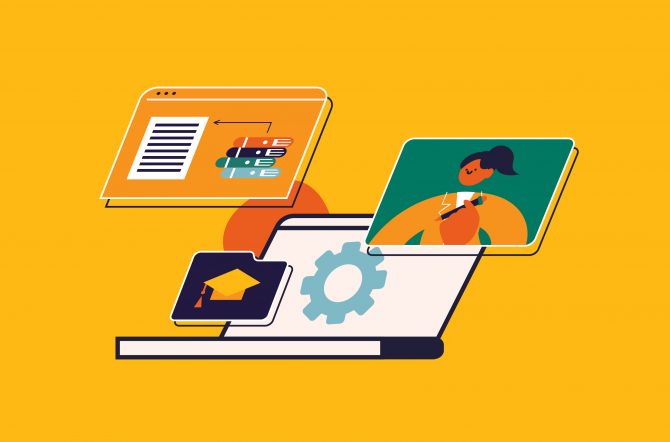Do you know that the eLearning industry is expected to top $375 billion by 2026 since the usage of eLearning has soared as whole businesses or sectors have gone online in 2020? If you’re a trainer or educator, you’ll have a lot of resources at your disposal for delivering high-quality training. Is your learning and development tools, on the other hand, capable of meeting a wide range of requirements? Do they cater to various types of students? Or do you prefer to work with a variety of learners? Or do we rely on the plethora of technology at our disposal? To put it another way, how complete is your L&D toolkit?
5 must-have learning and development tools for 2023
Here are some of our favorite IT L&D tools to add to your organization’s toolbox. We believe that when these tools and trends develop in 2023, they will also help us stay competent and human.
- Course authoring tools
- LMS
- LXP
- Microlearning
- Virtual Instructor-Led platforms
1. Course authoring tools
The first name topping in the rundown list is course authoring tools which are platforms that empower the process of generating learning content and full courses for end-users. With these course authoring tools, you can freely choose whatever training forms that suit your company employees’ preferences, including slides, audio, video, etc. They are considered catalysts for accelerating the effectiveness of interactive eLearning development. The program is more extensive than a SCORM package or video material, and it includes a wide range of interactive activities. As a result, if your company is tight on the budget, it is recommended to do some researches to decide on which specific tools to lean on.
Preparation Checklist to Power your Digital Transformation
Wondering if you miss anything in your preparation to digitize your training? This is just what you need.
2. LMS
It’s past time to add this to your L&D lineup if you haven’t done that already. Undoubtedly, LMS is one of the most buzzwords regarding Learning and Development tools. LMS software works as a single center for all of your eLearning content. It can help you save money, increase employee engagement, save L&D time, and measure progress and compliance. An LMS can help you strengthen business culture, maintain consistency across several sites, and swiftly train personnel on new procedures; with all of these benefits, you can’t afford to miss this chance. And, since learning platforms are rapidly changing, building on the fundamental capabilities of classic LMS while also including new features to improve the administrator’s capacity to offer more dynamic learning experiences. To find out more about different LMS products in the market, read here.
3. LXP
Learning Experience Platform snagged the third rank in our favorite list. Unlike LMS, with the main focus on tracking and conformity, LXPs, when being adopted in training, will allow trainees to have a tailored, online learning experience. Specifically, learners are capable of accessing the training sources via social media, website blogs, so on. Employees in major companies are the most common XLP customers, as they get a complete learning experience from multi-platforms.
Recommend reading:
4. Microlearning tools
What if employees say that they don’t have any free time for extra pieces of training and they have worked for the company for several years, which means training is only necessary for newcomers, not them? In that case, as an L&D training manager, what would you do? In fact, you are not the only leader to face this situation. It actually happens frequently, even in big corporations. According to Deloitte’s research, their employees said they have around 1% of their weekly time available for training. Over the course of a five-day workweek, it equates to 4.8 minutes each day.
To deal with this training confrontation, we recommend microlearning, one of the most prevalent L&D tools in recent years, which will completely change the learning experiences with only 4.8-minute daily training sessions. Employees may study in their spare time on a gadget they very certainly already have on them. Microlearning can be in the form of text, videos, audio, quizzes, or point-of-need, and it’s becoming more popular since it’s easier to create and absorb. What are the most trending microlearning tools? Let’s dive in here!
Recommend reading:
5. Virtual Instructor-Led platforms (VILT)
Traditional Instructor-led may take a few steps back in the digital transformation era, but it will never be replaced by any new flashy tools. The reason lies in human interaction being a must-have factor to achieve the highest level of learning, which is metacognitive, as mentioned in the knowledge dimension chart. That’s why a new wine in the old bottle is born, and virtual instructor-led platforms are chosen to present in our list. They are L&D tools that are witnessing an increase during the pandemic. Their mechanism is simple in which a facilitator conducts a remote training class using a virtual learning platform or software. VILT or virtual instructor-led platforms establish a synchronous remote learning environment in which users may communicate and learn in real-time. Beyond Zoom and Team, what are the best VILT options to embrace in years away?
Conclusion
These kinds of learning and development tools are at the heart of how you offer digital training and, in the end, define its effectiveness. Everyone benefits from having the proper ones, from corporate executives and managers to employees and consumers.

Sean Bui, the founder and creative director of F.Learning Studio, is a respected leader in the e-learning and multimedia production industry. With over 10 years of experience, he has dedicated his career to helping organizations create engaging and impactful learning experiences.
Under his leadership, F.Learning Studio has grown into a trusted partner for organizations in the education, healthcare, and corporate training sectors, producing over 2,000 minutes of educational animation.




